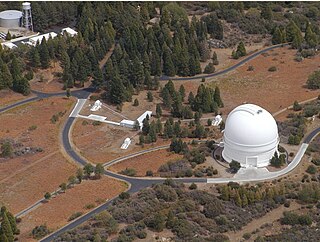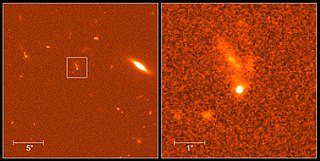Related Research Articles

Palomar Observatory is an astronomical research observatory in San Diego County, California, United States, in the Palomar Mountain Range. It is owned and operated by the California Institute of Technology (Caltech). Research time at the observatory is granted to Caltech and its research partners, which include the Jet Propulsion Laboratory (JPL), Yale University, and the National Optical Observatories of China.

A robotic telescope is an astronomical telescope and detector system that makes observations without the intervention of a human. In astronomical disciplines, a telescope qualifies as robotic if it makes those observations without being operated by a human, even if a human has to initiate the observations at the beginning of the night, or end them in the morning. It may have software agents using Artificial Intelligence that assist in various ways such as automatic scheduling. A robotic telescope is distinct from a remote telescope, though an instrument can be both robotic and remote.

Siding Spring Observatory near Coonabarabran, New South Wales, Australia, part of the Research School of Astronomy & Astrophysics (RSAA) at the Australian National University (ANU), incorporates the Anglo-Australian Telescope along with a collection of other telescopes owned by the Australian National University, the University of New South Wales, and other institutions. The observatory is situated 1,165 metres (3,822 ft) above sea level in the Warrumbungle National Park on Mount Woorat, also known as Siding Spring Mountain. Siding Spring Observatory is owned by the Australian National University (ANU) and is part of the Mount Stromlo and Siding Spring Observatories research school.

Neil Gehrels Swift Observatory, previously called the Swift Gamma-Ray Burst Explorer, is a NASA three-telescope space observatory for studying gamma-ray bursts (GRBs) and monitoring the afterglow in X-ray, and UV/Visible light at the location of a burst. It was launched on 20 November 2004, aboard a Delta II launch vehicle. Headed by principal investigator Neil Gehrels, at Goddard Space Flight Center (GSFC), the mission was developed in a joint partnership between GSFC and an international consortium from the United States, United Kingdom, and Italy. The mission is operated by Pennsylvania State University as part of NASA's Medium Explorer program (MIDEX).
The Automated Patrol Telescope (APT) was a wide-field CCD imaging telescope, operated by the University of New South Wales at Siding Spring Observatory, Australia.

The Indian Astronomical Observatory (IAO), located in Hanle near Leh in Ladakh, India, has one of the world's highest located sites for optical, infrared and gamma-ray telescopes. It is operated by the Indian Institute of Astrophysics, Bangalore. It is currently the tenth highest optical telescope in the world, situated at an elevation of 4,500 meters (14,764 ft).

BOOTES is a network of astronomical observatories with sites in Southern Spain, New Zealand, China, parts of the United States in Michigan and Mexico. It is managed by Instituto de Astrofísica de Andalucía. The main goal of the network is to quickly observe transient events within seconds or minutes of being detected by scientific satellites.

PROMPT, an acronym for Panchromatic Robotic Optical Monitoring and Polarimetry Telescopes, is being built by the University of North Carolina at Chapel Hill at Cerro Tololo Inter-American Observatory (CTIO) in Chile. PROMPT's primary objective is rapid and simultaneous multiwavelength observations of gamma-ray burst afterglows, some when they are only tens of seconds old. In addition to measuring redshifts by dropout, and early-time SFDs and extinction curves of sufficiently bright afterglows in unprecedented detail, PROMPT will facilitate quick response observations at larger observatories such as the UNC-led 4.1-m SOAR Telescope. PROMPT will also serve as a platform for undergraduate and high school education throughout the State of North Carolina.

GRB 970508 was a gamma-ray burst (GRB) detected on May 8, 1997, at 21:42 UTC; it is historically important as the second GRB with a detected afterglow at other wavelengths, the first to have a direct redshift measurement of the afterglow, and the first to be detected at radio wavelengths.

GRB 990123 is a gamma-ray burst which was detected on January 23, 1999. It was the first GRB for which a simultaneous optical flash was detected. Astronomers first managed to obtain a visible-light image of a GRB as it occurred on January 23, 1999, using the ROTSE-I telescope in Los Alamos, New Mexico. The ROTSE-I was operated by a team under Dr. Carl W. Akerlof of the University of Michigan and included members from Los Alamos National Laboratory and Lawrence Livermore National Laboratory. The robotic telescope was fully automated, responding to signals from NASA's BATSE instrument aboard the Compton Gamma Ray Observatory within seconds, without human intervention. In the dark hours of the morning of January 23, 1999, the Compton satellite recorded a gamma-ray burst that lasted for about a minute and a half. There was a peak of gamma and X-ray emission 25 seconds after the event was first detected, followed by a somewhat smaller peak 40 seconds after the beginning of the event. The emission then fizzled out in a series of small peaks over the next 50 seconds, and eight minutes after the event had faded to a hundredth of its maximum brightness. The burst was so strong that it ranked in the top 2% of all bursts detected.

Gamma-ray astronomy is the astronomical observation of gamma rays, the most energetic form of electromagnetic radiation, with photon energies above 100 keV. Radiation below 100 keV is classified as X-rays and is the subject of X-ray astronomy.

GRB 991216, nicknamed the Beethoven Burst by Dr. Brad Schaefer of Yale University, was a gamma-ray burst observed on December 16, 1999, coinciding with the 229th anniversary of Ludwig van Beethoven's birth. A gamma-ray burst is a highly luminous flash associated with an explosion in a distant galaxy and producing gamma rays, the most energetic form of electromagnetic radiation, and often followed by a longer-lived "afterglow" emitted at longer wavelengths.
Fenton Hill Observatory is an astronomical research facility operated by Los Alamos National Laboratory in the Jemez Mountains of New Mexico, about 35 miles (56 km) west of Los Alamos. The site is home to several astronomical experiments and observatories spanning 30 acres (120,000 m2). It is also known as Technical Area 57 (TA-57) and is located at an elevation of 8,700 feet (2,700 m) in a region shielded from light pollution. Los Alamos National Laboratory has a use agreement with the Forest Service for the 30 acres (120,000 m2), which is located near Fenton Lake State Park.
The Livermore Optical Transient Imaging System, or LOTIS, is an automated telescope designed to slew very rapidly to the location of gamma-ray bursts (GRBs), to enable the simultaneous measurement of optical counterparts. Since GRBs can occur anywhere in the sky, are often poorly localized, and fade very quickly, this implies very rapid slewing and a wide field of view. To achieve the needed response time, LOTIS was fully automated and connected via Internet socket to the Gamma-ray Burst Coordinates Network. This network analyzes telemetry from satellite such as HETE-2 and Swift Gamma-Ray Burst Mission and delivers GRB coordinate information in real-time.. The optics were built from 4 commercial tele-photo lenses of 11 cm aperture, with custom 2048 X 2048 CCD cameras, and could view a 17.6 X 17.6 degree field.
Super-LOTIS is the second incarnation of the Livermore Optical Transient Imaging System, located at the Steward Observatory on Kitt Peak. It is an automated telescope designed to slew very rapidly to the location of gamma-ray bursts (GRBs), to enable the simultaneous measurement of optical counterparts. GRBs can occur anywhere in the sky, fade very quickly, and were initially poorly localized, so the original LOTIS needed very rapid slewing and an extremely wide field of view. However, this wide field of view meant it could not see faint sources, and only the brightest GRB afterglows could be studied.
Timothy A. McKay is an astrophysicist and the Arthur F. Thurnau Professor of Physics at the University of Michigan. He is actively involved in physics education, including courses on “Physics for the Life Sciences” and Saturday Morning Physics. As of 2013, McKay's papers have over 30,000 citations and an h-index of 66. He considers publication and education vital to the scientific enterprise: “science isn’t science until you’ve shared it with someone else.”
Time-domain astronomy is the study of how astronomical objects change with time. Though the study may be said to begin with Galileo's Letters on Sunspots, the term now refers especially to variable objects beyond the Solar System. This may be due to movement or changes in the object itself. Common targets included are supernovae, pulsating stars, novas, flare stars, blazars and active galactic nuclei. Visible light time domain studies include OGLE, HAT-South, PanSTARRS, SkyMapper, ASAS, WASP, CRTS, and in a near future the LSST at the Vera C. Rubin Observatory.
Carl Akerlof is a particle physicist and astrophysicist at the University of Michigan. He initiated and led the Robotic Optical Transient Search Experiment (ROTSE), a ground-breaking effort to find fast astrophysical optical transients, particularly gamma-ray bursts. A fellow of the American Physical Society. he has co-authored over 400 papers with 1500 collaborators, which have been cited over 6000 times.

ULTRASAT is an astronomical small satellite whose unprecedentedly large field of view, 210 square degrees, will detect and monitor transient astronomical events in the near-ultraviolet (220–280 nm) spectral region. ULTRASAT will observe a large patch of sky, alternating every six months between the southern and northern hemisphere. The satellite will be launched into geosynchronous orbit in early 2025. All ULTRASAT data will be transmitted to the ground in real time. Upon detection of a transient event, ULTRASAT will provide alerts within 20 minutes to other ground-based and space telescopes to be directed to the source for further observation of the event in other wavelength bands.
References
- 1 2 "ROTSE-III World Distribution" . Retrieved 11 September 2010.
- ↑ "Project Information" . Retrieved 11 September 2010.
- ↑ Akerlof, C.W. and Ashley, MCB and Casperson, DE and Epps, HW and Kehoe, RL and Marshall, SL and McGowan, KE and McKay, TA and Phillips, MA and Rykoff, E.S.; et al. (2002). "The ROTSE-III robotic telescope system". Publications of the Astronomical Society of the Pacific. 115 (803): 132–140. arXiv: astro-ph/0210238 . Bibcode:2003PASP..115..132A. doi:10.1086/345490. S2CID 10152025.
{{cite journal}}: CS1 maint: multiple names: authors list (link)